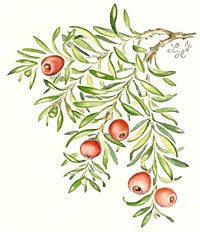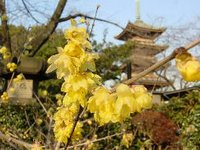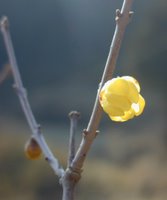[ . BACK to Worldkigo TOP . ]
:::::::::::::::::::::::::::::::::::::::::::::::::::::::::::::::::::::::::::::::::::::::::::::::::::::
Winter drizzle, sleet (shigure)
***** Location: Japan, other areas
***** Season: Early Winter
***** Category: Heaven
*****************************
Explanation
There are many Japanese kigo related to this kind of early cold rain in the overlapping time from autumn to winter. According to the weather patterns of this season, when cold air masses come down from Siberia, the rains come and go fast, as is represented in the Chinese characters, meaning "rain for a (short) time".
It might hit you unexpectedly on a mountain pass and leave a thin white cover on the peaks. Most common in Northern Japan, these showers come fast and leave fast, so it may rain here and shine there (kata shigure 片時雨).
The short cold drizzle evokes many melancholic feelings for the Japanese haiku poet. It is a symbol of the passing of events in the human life, of the passing of life itself.
It is also something that can be enjoyed
hearing, it makes a hushing sound and this kind of sound is reflected in other kigo, for examle the famous cicada shrilling (semi shigure 蝉時雨). I often go to our local shrine and listen to the shigure on the roof, quite an eeerie sound!
These drizzle kigo have mostly been used already since the Heian period and are well loved and full of allusions to famous poems. SHIGURE is a good example to show that kigo are much more than just the weather report.
 - shigure 時雨 winter drizzle, sleet -
. Matsuo Basho 松尾芭蕉 - Archives of the WKD .
- shigure 時雨 winter drizzle, sleet -
. Matsuo Basho 松尾芭蕉 - Archives of the WKD .
... ... ...
rain mixed with snow, cold rain, snowy drizzle, sleet (shigure 時雨)
winter drizzle in the morning, asa shigure 朝時雨
winter drizzle in the evening, yuushigure 夕時雨
nightly drizzle, sayo shigure 小夜時雨, さよしぐれ
"village shower", passing winter shower, mura shigure 村時雨
murashigure
The sound of sleet sounding on the thatched roofs of a village in the Edo period.
first winter shower of the season, hatsushigure 初時雨 はつしぐれ
..... first cold rain after the 8th of November
"shower month" 10th month of the old lunar calendar,
shigurezuki 時雨月, しぐれづき
scattered winter showers, kata shigure 片時雨
winter drizzle from the North, kita shigure 北時雨
winter drizzle from the side, yoko shigure 横時雨
winter drizzle in the Kitayama (North Mountain) district of Kyoto
..... Kitayama shigure 北山時雨
"rain in the mountains", yamameguri 山めぐり
soaking cold rain, eki-u 液雨, えきう
..... an old Chinese term for the cold rains, starting from 10 days after the beginning of winter (立冬) as
beginning of the winter drizzle season, nyuueki 入液
autum leaves coloring in a winter drizzle, shigure iro 時雨の色 しぐれのいろ
"sound of the drizzle in a river", kawa oto no shigure 川音の時雨
..... the river sounds like a winter drizzle
"sound of a drizzle in the pines", matsukaze no shigure 松風の時雨
..... the wind in the pines sounds like a winter drizzle
"sound of a drizzle on the autumn leaves",
ko no ha no shigure 木の葉の時雨
..... the rustling of leaves sounds like a winter drizzle
.. all expressions known since the Heian period.
clouds of a winter drizzle, shiguregumo 時雨雲
umbrella for a winter drizzle, shiguregasa 時雨傘
"It feels like a drizzle", shigure gokochi 時雨心地 しぐれごこち
drizzling, sleet is falling, shigururu しぐるる
"tears like a winter drizzle", namida no shigure 涙の時雨
"a sleeve wet from cold tears" tamoto no shigure 袖の時雨
..... expressions used since the Heian period
a famous folk-song called "Sansa Shigure" さんさ時雨
(photos)
In 福島市 Fukushima city 飯坂町 Iizaka
While walking and working in the mountain forest, it is not allowed to sing or recite サンサしぐれ / さんさ時雨 the Sansa Shigure, a folk song from Miyagi, dating back to 1589 and the warlord 伊達政宗 Date Masamune.
. Yamanikami 山の神 and Legends from Fukushima .
:::::::::::::::::::::::::::::::::::::::::::::::::::::::::::::::::::::::::::::::::::::::::::::::::::::
sleet in spring, haru shigure 春時雨
... haru no shigure 春の時雨(はるのしぐれ)
kigo for spring
. . . . .
sleet in autumn, aki shigure 秋時雨
kirishigure 霧時雨(きりしぐれ)"fog and sleet"
kigo for autumn
. . . . .
sleet and snow, yuki shigure 雪時雨
kigo for late winter
:::::::::::::::::::::::::::::::::::::::::::::::::::::::::::::::::::::::::::::::::::::::::::::::::::::
kigo for all winter
mizore 霙 (みぞれ) sleet
yukimajiri 雪雑り(ゆきまじり)
yukimaze 雪交ぜ(ゆきまぜ)
けしからぬ月夜となりしみぞれ哉
keshikaranu tsuki yo to narishi mizore kana
look out!
moonlight slicked
with sleet
Tr. Chris Drake
This hokku was written at the end of the 10th month (November) in 1803, while Issa was staying at the house of a student in the area just east of Edo.
The meaning of
keshikaranu in the first line is a bit complex. Keshikaranu literally means "not just unusual," that is, extreme, very bad, awful, terrible, suspicious, weird, very strange, or just "very X,Y,Z."
In Issa's time it could sometimes be used in a positive as well as a negative sense, depending on the context, but in contemporary Japanese the meaning is usually strongly negative. In terms of weather, the 1603 Japanese-Portuguese dictionary, which is based on the actual speech at the time, says "extreme weather" (
keshikaranu tenki) was a standard phrase that meant "extremely bad weather." (In English the meaning of the phrase isn't much different.)
In Edo, where Issa was living,
keshikaranu meant the equivalent of modern Japanese
hidoi (severe, intense, hard, frightful, outrageous, terrible, dreadful) or
taihen da (terrible, awful, very serious, countless, enormous, disastrous; often used as an exclamation). I take Issa to be exclaiming at the sudden sleet storm that takes place while the moon is still out, as if he were talking to a companion or to himself as he takes cover. The next hokku in his diary evokes someone sweeping away sleet from the ground near a house, so a fair amount of sleet must have fallen.
Chris Drake
. Kobayashi Issa 小林一茶 Issa in Edo .
:::::::::::::::::::::::::::::::::::::::::::::::::::::::::::::::::::::::::::::::::::::::::::::::::::::
Read more about "Shigure" in the University of Virginia Saijiki
Click HERE to see more items of Japanese Culture with
the name of SHIGURE
Sweets, rice wine, special regional dishes and many more
*****************************
Worldwide use
*****************************
Things found on the way
 Shigure-Den 時雨殿 in Kyoto
Shigure-Den 時雨殿 in Kyoto
The two-story Shigure-den (
Autumn Shower Palace) in Arashiyama is a museum where people can experience and learn about the
Hyakunin Isshu. This building is two storeys high. In the main room, there are many 45-inch, liquid-crystal monitors that display 70 large karuta cards and images of the city of Kyoto on the floor. You can take part in several activities here.
© Kyoto University of Foreign Studies.
Card Games (karuta) Japanese Poetry and Haiku

.................................................................................
. WASHOKU
Shigure no Matsu 時雨の松 sweet
In Memory of Matsuo Basho
:::::::::::::::::::::::::::::::::::::::::::::::::::::::::::::::::::::::::::::::::::::::::::::::::::::
. Teri-furi ningyoo 照り降り人形 "weather forecasting dolls" .
ji-u ningyoo 晴雨人形 shine and rain dolls
**********************************
HAIKU
 the sound of iced rain
the sound of iced rain
dripping
in the bamboo grove
©
Photo and Haiku
Gabi Greve, 2005
:::::::::::::::::::::::::::::::::::::::::::::::::::::::::::::::::::::::::::::::::::::::::::::::::::::
音は時雨か
oto wa shigure ka
the sound, oh,
it's sleet !
Santoka (Santooka 山頭火)
Read a discussion of the Translating Haiku Forum
:::::::::::::::::::::::::::::::::::::::::::::::::::::::::::::::::::::::::::::::::::::::::::::::::::::
. Matsuo Basho 松尾芭蕉 - Archives of the WKD .
初しぐれ猿も小蓑をほしげ也
hatsushigure saru mo komino o hoshigenari
first snow shower -
even the monkeys would want
a straw raincoat
MORE in - Sarumino 猿蓑
Monkey's Raincoat -
. Matsuo Basho 松尾芭蕉 - Archives of the WKD .
.................................................................................
 霧時雨 富士を見ぬ日ぞおもしろき
霧時雨 富士を見ぬ日ぞおもしろき
kiri-shigure Fuji o minu hi zo omoshiroki
misty rain.
the day when I don't see Mt. Fuji:
most fascinating!
(Tr. Susumu Takiguchi)
in the misty rain
Mount Fuji is veiled all day --
how intriguing!
(Tr. Makoto Ueda)
Misty rain;
Today is a happy day,
Although Mt. Fuji is unseen.
(Tr. thegreenleaf.co.uk )
.................................................................................
今日斗り人も年よれ初時雨
けふ斗人もとしよれ初しぐれ」
今日ばかり人も年寄れ初時雨
kyoo bakari hito mo toshiyore hatsu shigure
today is a day
when people just (huddle and) grow old -
first winter drizzle
Tr. Gabi Greve
今日ばかり人も年寄れ初時雨」。冬の寒空から落ちてくる初時雨、人々はみな身をちじめて、なんだか年をとってしまったようだ.
kyoo bakari . . . today is one of these days
Read the translations of Ueda and Barnhill :
. Getting Old with Haiku .
:::::::::::::::::::::::::::::::::::::::::::::::::::::::::::::::::::::::::::::::::::::::::::::::::::::
. WKD : Kobayashi Issa 小林一茶 in Edo .
度々にばか念入てしぐれ哉
tabi-tabi ni baka-nen irete shigure kana
again and again
idiotically fastidious
cold rain showers
Tr. Chris Drake
This hokku is from the 9th month (October) of 1821, when Issa was in his hometown.
Shigure are intermittent short, hard, cold rain showers, sometimes short squalls, that come one after the other in systems of fast-moving clouds in late autumn and early winter, though occasionally they occur in spring and summer. In waka they are often referred to as capricious or unreliable. Just when blue sky returns and you think the showers are over, another one begins pelting down, and just when the rain seems to be falling harder, it stops. These continuous intermittent showers are different from steady cold rain or from late afternoon downpours (yuudachi) that soon leave the sky clear. In Issa's time these cold rain showers were regarded as either a winter or an autumn image, depending on the context or the other images in the hokku.
This hokku by Issa happens to be an autumn verse because it's from the 9th month. The cold showers in 1821 seem to be quite vigorous, and to Issa the never-satisfied rain seems to obsessively and fastidiously fall in irregular bursts that again and again defeat human expectations.
Chris Drake
:::::::::::::::::::::::::::::::::::::::::::::::::::::::::::::::::::::::::::::::::::::::::::::::::::::
hibi hibi ni shigure no fureba hito oinu
day after day after day
only cold drizzle with snow ー
I am getting older
Ryokan (Ryookan 良寛)
xxxxxxxxxxxxxxxxxxxxxxxxxxxxx
More Winter drizzle / shigure / Japanese haiku
時雨:日本語の俳句集
:::::::::::::::::::::::::::::::::::::::::::::::::::::::::::::::::::::::::::::::::::::::::::::::::::::
... when Bashō composes a haiku that is the same as one by Sōgi but for one word
yo ni furu mo/ sara ni Sōgi no/ yadori kana
世にふるも さらに宗祇の やどり哉
yo ni furu mo/ sara ni shigure no/ yadori kana
よにふるも さらにそうぎの やどりかな
his poem is considered an original work, for that one word, that one small change, alters the whole. The new poem thereby establishes roots, and strengthens the roots of its predecessor, in the native tradition.
Translators constantly make such changes; this is unavoidable when one is transferring data from one language into another, for there are no perfect inter-lingual synonyms. Is their work not therefore original?
© Michael Haldane
Iio Sogi (1421 - 1502)
Passing through the world
Indeed this is just
A shelter from the shower.
Life in this world
is brief as time spent sheltered
from winter showers
The Green Leaf
*****************************
Related words
***** cicada shower, cicada chorus, semi shigure
蝉時雨 (せみしぐれ)
kigo for late summer
..... see
Cicada (semi)
***** dew shower, tsuyu shigure 露しぐれ,つゆしぐれ
kigo for autumn
..... see
Dew, dewdrops (tsuyu)
***** insect shower, insect chorus, mushi shigure 虫時雨 むししぐれ
kigo for autumn
..... see
Insects (mushi)
***** Winter-Drizzle Anniversary, Bashō's (Death) Anniversary / Basho's Memorial Day, shigure ki 時雨忌 しぐれき
kigo for early winter
..... see
Basho Memorial Day (Basho-Ki)
.. .. .. .. Rain in various KIGO (Japan)
*****
Tear, tears (namida) Japan. Träne, Tränen
[ . BACK to WORLDKIGO . TOP . ]
:::::::::::::::::::::::::::::::::::::::::::::::::::::::::::::::::::::::::::::::::::::::::::::::::::::




























